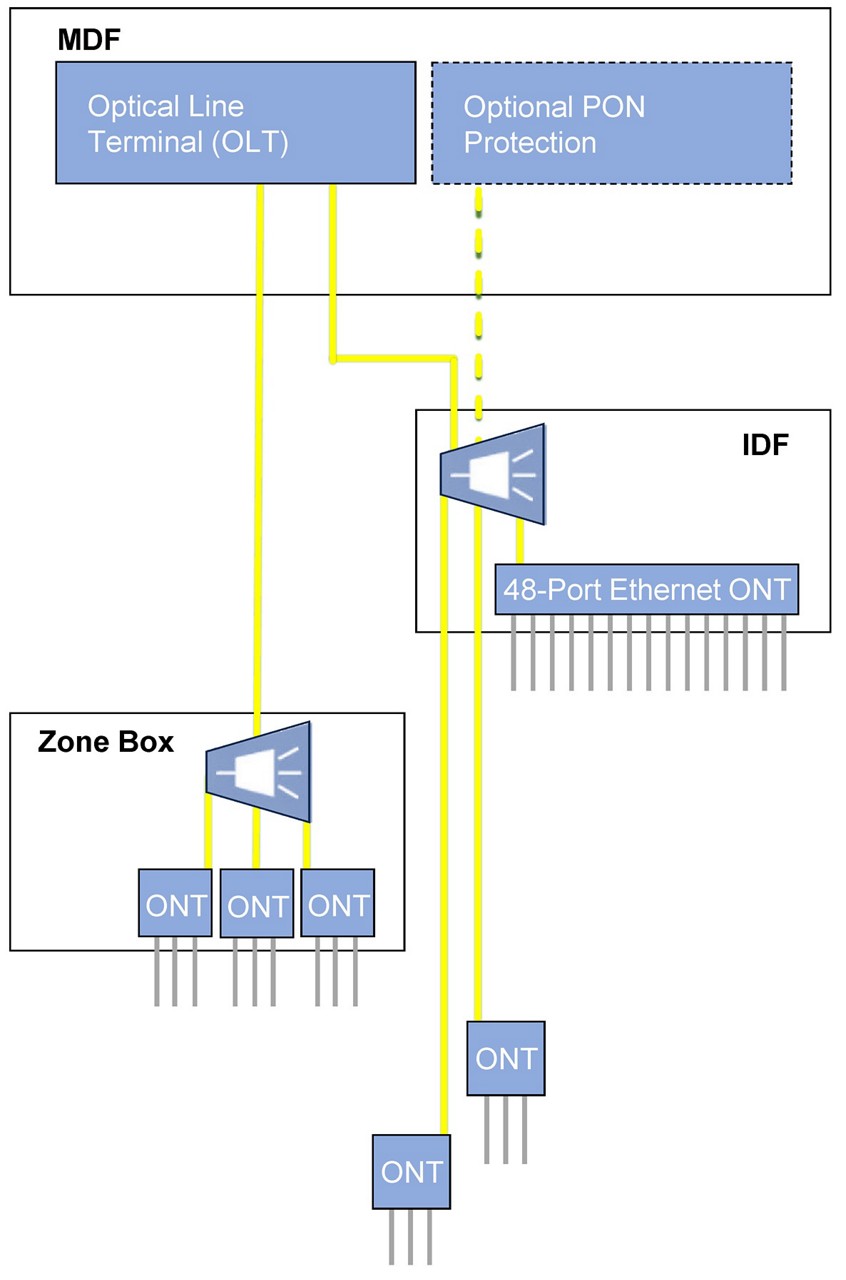Enterprise businesses that need to upgrade or replace existing telecommunications networks are looking for ways to improve energy efficiency and sustainability – both wireless and wireline. Technology managers are looking for solutions that supply high bandwidth while increasing the security and reliability of their networks, all while reducing capital and operating expenses.
To meet these requirements, enterprises are turning to fiber-based network technologies. Optical local area networks (Optical LANs) provide value to enterprises without forcing them to alter how they do business, while existing services provided by their networks remain the same with no change to core and end devices connected.
The benefits of fiber-based LANs for enterprises start with:
- Fiber is technology independent
- Fiber cabling allows for greater reach
- Fiber offers graceful migration from 1 to 100 gigabits
How does Optical LAN Work?
Optical LAN is an IT infrastructure founded on standards-based passive optical network (PON) technologies (2.5G asymmetrical G-PON and 10G symmetrical XGS-PON) and standards-based advanced Ethernet technologies. The five main pieces of an Optical LAN system include:

- Network Manager - The PON manager (i.e., element manager) is the centralized intelligence and management of the PON elements and subtended powered devices (i.e., powered devices). The PON manager provides one console and one screen control to orchestrate consistent, repeatable, error-free IT policies and procedures through global profiles. This is the user interface that IT staff will access to perform faster network provisioning, configurations, moves, adds, changes, and troubleshooting.
- Optical Line Terminal (OLT) - The OLT is typically located in the building’s main data center and provides aggregation plus distribution of the enterprise network connectivity. A single OLT can be sized to support anywhere from two Ethernet connections to over 8,000 Ethernet connections from a single location. It is the OLT that connects to the wide area network (WAN) and all internal resource servers through the core router. OLTs range in size from one to four rack units in height, and even with the inclusion of powering equipment and fiber management, typically all fits in one standard 19-inch rack.
- Singlemode Fiber (SMF) - SMF cabling runs throughout the building’s risers and pathways and SMF physically connects the OLT, splitters, and optical network terminals (ONTs). While SMF is most common, there are options for operating PON over multimode fiber (MMF) and there are mounted closet-based ONTs that can leverage the last 300 feet of copper cabling. Composite SMF cabling that includes a copper wire pair within the cabling jacket can also be used for remote powering of the ONTs
- Passive Optical Splitters - Optical splitters provide the point-to-multipoint connectivity between the OLT and the ONTs. The splitters offer flexible mounting in telecom closets, wall enclosures, or ceiling enclosures. They offer split ratios from 1:2 up to 1:64 with the most common split ratio being 1:32. Optical splitters also provide equipment, fiber, and services protection through 2:X redundancy options. They are unmanaged, unpowered, and highly reliable.
- Optical Network Terminal (ONT) - ONTs enable optical to electrical conversion and Ethernet connectivity for voice, video, data, Wi-Fi, and all other digital enterprise services and devices. ONTs are Power over Ethernet (PoE) enabled and subtend other powered devices (e.g., phones, cameras, wireless access points). ONTs themselves can be either locally powered from a nearby AC outlet, or remotely powered from a Class 2 or Class 4 Fault Managed Power (FMP) source. ONT mounting can be located above the desk, below the desk, or can be nearly flush mounted in the wall. They can also be mounted in zone boxes with optional plenum brackets and in raised floors.
Optical LAN for Enterprises
Optical LAN for enterprise is an alternate way to build and operate networks. Optical LAN speeds IT productivity through simplification, resulting in reduced manpower needed for simple daily moves, adds, and changes. It eliminates many known IT vulnerability points, shrinking the network attack surface, and is ideal for zero trust architecture. It offers flexible design options to right-size capacity (e.g., 1 gig to 10 gig) and density (e.g., ten to thousands of connected users and devices).
Optical LAN is optimized for modern fiber-based network connectivity inside buildings and across campus, with growing utilization in markets such as:
- Hospitality
- Education
- Government
- Healthcare
- Large venues
In this rapidly adapting business climate, it is important that stakeholders have vetted all options. Tellabs and Panduit stand ready as trusted advisors to help navigate organizations through the myriad of choices for simple, secure, scalable, and sustainable connectivity. The combined team unites network designers, installers, integrators, and operators on a common goal to recognize these significant technology transitions and take full advantage of them.
For more information about Optical LAN solutions from Panduit and Tellabs, you can download a detailed solution overview.


